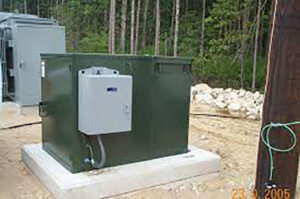As global warming and the effects of climate change push our planet closer to serious issues, such as rising sea levels, unpredictable weather phenomena, and potential long-term health and safety issues, many people and organizations are scrambling to find ways to reduce their greenhouse gas emissions. While we can all directly reduce our carbon footprints and help slow the damage we’ve already done, getting to true zero emissions has proven difficult.
Fortunately, other creative avenues can help individuals and organizations reach their net-zero emissions goals while still producing some currently unavoidable greenhouse gas emissions. Two ways you can do this are by purchasing renewable energy certificates (RECs) and carbon offsets.
While these two purchasable offset methods are similar, they have distinct differences that make them two wholly different items. Which is the right option for you? We review RECs vs. carbon offsets below to highlight their individual uses, benefits, and drawbacks so you can make an informed decision regarding which is your best option.
What Is the Purpose of Carbon Offsets?
Carbon offsets, which are also referred to as carbon offset credits, offset credits, or even carbon reduction credits, allow individuals and organizations to offset their carbon footprint by buying into or investing in projects that are carbon reducing or carbon sequestering (which involves capturing and storing carbon).
For example, if you took a plane ride in an airliner with 150 seats that produced 20 metric tons of carbon dioxide (CO2), your carbon footprint for that flight is 0.133 metric tons of CO2 (20 tons divided by 150 seats equals 0.133). To offset that carbon footprint, you can invest in a project that reduces or absorbs greenhouse gas emissions (GHG emissions) by the same 0.133 metric tons.
These offset projects vary greatly and can include:
- Renewable energy source installation
- Reforestation
- Deforestation prevention
- GHG emission reduction
- Low-energy equipment installation
- Tree planting on a corporate campus
- Methane recapturing at landfills
Are Carbon Credits the Same as Offsets?
While commonly used interchangeably, carbon offsets and carbon credits are not the same things — though they are very similar.
A carbon offset is the removal of GHG emissions from the atmosphere. These offsets are produced by independent organizations, verified by a third party, and sold to GHG-emitting organizations or individuals on the voluntary carbon market.
A carbon credit is a government-created item awarded to an organization. It represents the amount of GHG emissions an organization can create. If the organization reduces its GHG emissions and has excess credits, it can sell those credits to other organizations that exceed their GHG allowance via the carbon compliance market.
What Is the Purpose of RECs?
Renewable energy certificates (RECs) are also known as renewable energy credits, and they help an individual or business reach their renewable energy generation goals without having to install the infrastructure.
According to the Environmental Protection Agency (EPA), when an organization installs a renewable energy source — such as wind, water, or solar — they receive one REC per megawatt-hour (MWh) that the source creates.
The organization can choose to keep that credit for themselves to satisfy governmental regulations or sell it to another individual or organization. If someone or an entity purchases a REC, this applies to any governmental regulations they must meet.
For example, if a company must get at least 10% of its electricity from a renewable source and doesn’t want the expense of installing solar panels, many state and local governments will allow it to purchase enough RECs to make up that 10%.
Organizations can also use RECs to help them substantiate carbon-reduction claims. For example, a company claiming to be a net-zero GHG emissions producer can use RECs to reduce any leftover emissions they cannot reduce themselves.
You may hear that your power company has a solar panel or wind farm and assume that will help you satisfy your renewable energy goals. Unfortunately, there’s no way to determine how much of your energy comes from these sources, so RECs can also step in here to help with accounting and tracking your energy sources.
How Are RECs Different From Carbon Credits?
OK, so carbon credits and RECs each help improve the environment and aim to slow climate change, but how do they differ? A few key differences exist between the two.
First, RECs are measured by MWh of electricity produced by a green power source, such as solar panels, a hydroelectric plant, or a wind turbine. Carbon offsets are measured in metric tons of CO2 emissions that have been avoided through policy changes, upgraded equipment, or absorption by plant life.
Second, RECs are solely generated by non-fossil-fuel clean energy sources — and nothing else. Carbon offsets can come from various green programs, including renewable energy installation, GHG reduction technology, reforestation, preventing deforestation, and more.
Third, an individual or organization can use carbon offsets to counter their scope 1, 2, or 3 emissions as needed. However, RECs can only offset scope 2 emissions, which are the emissions produced by the energy it consumes.
Fourth, an organization can use RECs to claim they use green energy from a low- or zero-emissions source. Carbon offsets only allow them to claim that they reduced or avoided emissions outside their operation.
Finally, carbon credits require a test of additionality, meaning the reduction project you’re buying into must be outside the normal business operations of the organization involved in the project. RECs do not require a test of additionality.
RECs vs. Carbon Offsets: Which Is Better?
Now for the billion-dollar question — which is better, RECs or carbon offsets? Honestly, one is no better than another. It all depends on what your goal is. Let’s dive deeper into this below.
Why Are Renewable Energy Certificates Better Than Carbon Offsets?
Purchasing RECs is superior to offsets in that they allow the purchaser to make the claim they use green energy from a low- or zero-emissions source. This can be a powerful marketing tool and, in some states, may allow an organization to meet renewable energy use requirements.
Also RECs don’t have any additionality requirements, so they are theoretically simpler to find and purchase than offsets, and there’s no chance of them later being deemed invalid.
Why Are Carbon Offsets Better Than RECs?
Carbon offsets also have a few advantages compared to renewable energy certificates. The biggest is the wide range of projects you can invest in. This wide range of options allows an individual or organization to invest in sustainability programs with which it most closely aligns.
For example, if an individual is concerned with the future environmental impact of the waste from solar electricity generation, they can choose a carbon offset program focused on forestry issues and enjoy similar environmental benefits.
Also, carbon offsets reduce your carbon footprint as a whole, meaning they can apply to all three scopes of emissions and indirect emissions. On the other hand, RECs only impact scope 2 emissions by claiming the organization purchases renewable power.
Which Is Best for Me?
The answer to which is best really depends on what your goals are. If you’re looking to offset scope 1 or scope 3 emissions, the decision is simple: Offsets are better for you. This is because you can’t offset these emissions with RECs — only scope 2 emissions.
However, if you need to reduce scope 2 emissions, it’s more about analyzing the cost, availability, and your overall goals. If you want to meet governmental minimums on renewable energy sources and live in an area that permits you to use RECs to meet this requirement, then RECs are the best bet.
If you’re not looking to meet this governmental requirement and carbon offsets are easier to acquire and a more economical way to limit your overall carbon footprint — scope 1, 2, or 3 — then this may be the best option.
Can RECs Offset Carbon Emissions?
Today’s greenhouse gas emissions accounting standards permit organizations to use RECs to reduce reported scope 2 emissions. This counts toward the organization’s path to meeting its science-based GHG emission targets. These laws can change, so this is subject to the latest regulations.
Can You Use RECs to Offset Scope 1 Emissions?
The answer to this question is an emphatic no. Organizations cannot use RECs to offset scope 1 or scope 3 emissions. They are only accepted for scope 2 emission reductions. Scope 1 emissions are emissions produced directly through an organization’s operations and are in their direct control. They include:
- Company-owned delivery vehicles’ emissions
- Machinery emissions
- Unintentional chemical releases (such as oil spills, refrigerant leaks, etc.)
- Factory emissions from product manufacturing
Scope 3 emissions are those created indirectly through your value chain. Some examples of common scope 3 emissions include but aren’t limited to:
- Home delivery
- Employee commutes to work
- Warehousing
- Disposal of broken or worn-out products
- Business travel
- Leased assets
- Investments
RECs vs. Carbon Offsets: Both Can Be Beneficial
Debating RECS vs. carbon offsets isn’t necessarily a test of which is best. It’s more of a test of which is best suited for you. In many cases, the answer may be a mixture of both. It’s all about looking at your carbon footprint reduction goals and determining the best fit for your reduction plans.
If carbon offsets are the best fit for your goals, Terrapass can help with its wide range of carbon reduction options for individuals and businesses.
Get started with the right one for you! Whether you’re looking to offset the carbon emissions from a flight for a business trip or offset the carbon footprint of a wedding, Terrapass has options for you. And, if you feel RECs are more in line with your needs, Terrapass offers those as well.
Brought to you by terrapass.com
Featured image:
- SEO Powered Content & PR Distribution. Get Amplified Today.
- Platoblockchain. Web3 Metaverse Intelligence. Knowledge Amplified. Access Here.
- Source: https://terrapass.com/blog/recs-vs-carbon-offsets-demystifying-green-credit-purchases/
- 1
- 420
- a
- About
- Accounting
- acquire
- Adobe
- advantages
- airliner
- Aligns
- All
- allows
- already
- amount
- analyzing
- and
- Another
- answer
- Apply
- AREA
- Atmosphere
- auto
- availability
- avoided
- awarded
- because
- being
- below
- benefits
- BEST
- Bet
- Better
- between
- Biggest
- Broken
- business
- business operations
- Buying
- cannot
- Capturing
- carbon
- carbon credits
- carbon emissions
- carbon footprint
- cases
- certificates
- chain
- Chance
- change
- Changes
- chemical
- Choose
- claim
- claims
- Climate
- Climate change
- closely
- closer
- co2
- COM
- come
- Common
- commonly
- company
- compared
- compliance
- concerned
- control
- Corporate
- Cost
- Counter
- create
- created
- creates
- Creative
- credit
- Credits
- Currently
- decision
- deeper
- deforestation
- delivery
- depends
- Determine
- determining
- differ
- differences
- different
- difficult
- direct
- directly
- distinct
- divided
- Doesn’t
- Dont
- drawbacks
- each
- easier
- effects
- electricity
- emission
- Emissions
- energy
- energy use
- enjoy
- enough
- entity
- Environment
- environmental
- EPA
- Equals
- equipment
- etc
- Even
- example
- examples
- exceed
- few
- fight
- Find
- fit
- flight
- focused
- Footprint
- forest
- from
- future
- GAS
- generated
- get
- getting
- GHG
- Global
- global warming
- goal
- Goals
- governmental
- greatly
- Green
- greenhouse gas
- hand
- having
- Health
- hear
- help
- here
- Highlight
- Honestly
- How
- However
- HTTPS
- image
- Impact
- improve
- in
- include
- Including
- independent
- indirectly
- individual
- individuals
- informed
- Infrastructure
- install
- installing
- Invest
- investing
- involved
- issues
- IT
- items
- Keep
- Key
- known
- Late
- latest
- Laws
- Leaks
- LEARN
- Leftover
- levels
- Life
- LIMIT
- Limited
- Line
- live
- local
- long-term
- looking
- make
- many
- many people
- Market
- Marketing
- max-width
- meaning
- Meet
- meeting
- methods
- MIT
- mixture
- more
- most
- necessarily
- Need
- needed
- needs
- normal
- Offers
- offset
- Oil
- ONE
- operation
- Operations
- Option
- Options
- organization
- organizations
- Other
- outside
- overall
- panel
- panels
- party
- path
- People
- planet
- plans
- Planting
- plato
- Plato Data Intelligence
- PlatoData
- policy
- potential
- power
- power company
- powerful
- preventing
- Produced
- producer
- Product
- Program
- Programs
- project
- projects
- protection
- proven
- purchase
- purchaser
- purchases
- purchasing
- purpose
- Push
- question
- range
- reach
- receive
- reduce
- Reduced
- reduces
- reducing
- referred
- regarding
- regulations
- Releases
- removal
- Renewable
- renewable energy
- Reported
- represents
- require
- requirement
- Requirements
- review
- Ride
- rising
- Safety
- same
- scope
- SEA
- sell
- serious
- similar
- Simple
- slow
- So
- solar
- solar panel
- solar panels
- sold
- some
- Someone
- Source
- Sources
- standards
- started
- States
- Step
- Still
- subject
- such
- superior
- targets
- Technology
- test
- The
- The Future
- The Source
- their
- themselves
- things
- Third
- three
- Through
- to
- tons
- too
- tool
- toward
- Tracking
- true
- turbine
- unpredictable
- upgraded
- use
- value
- various
- verified
- via
- Waste
- Water
- ways
- Weather
- What
- whether
- which
- while
- wholly
- wide
- Wide range
- will
- wind
- wind turbine
- windmills
- without
- Your
- zephyrnet
- zero


















